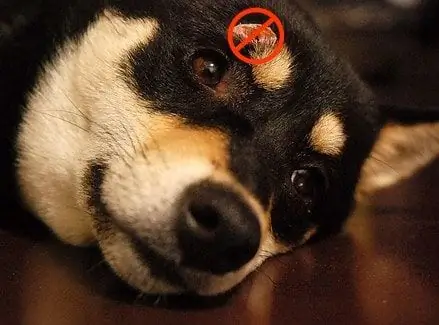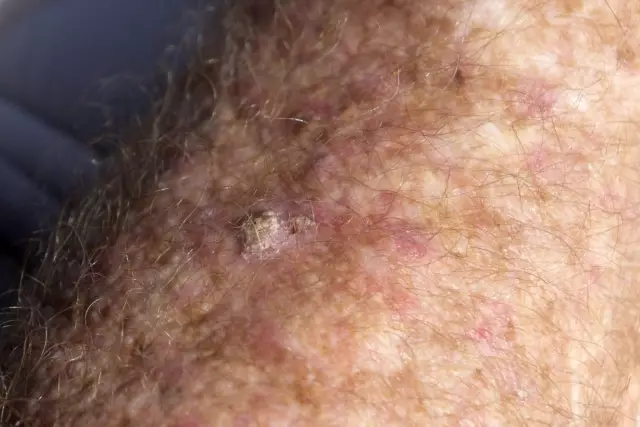
- Outeur Daisy Haig [email protected].
- Public 2023-12-17 03:04.
- Laas verander 2025-01-24 12:33.
Albei my Franse bulhonde het gely met lelike, dikwels jeukerige en tegnies goedaardige gewasse wat ons histiocytomas noem. Alhoewel histiocytomas gewoonlik na twee tot drie maande verdwyn, lei die onsekerheid van die herkoms van hierdie gewas daartoe dat die meeste veeartse dit afknip (of ten minste 'n deel daarvan) om die goedheid daarvan te verseker.
'N Chirurgiese skalpellering van 'n' goedaardige 'massa mag vir u uiters klink, maar aangesien histiocytomas irriterend en eng kan wees, word chirurgie dikwels aangedui.
Irriterend: Omdat hulle dikwels op die kop en voete verskyn, kan daar maklik gekrap of gelek word met 'n volkome ronde, gesweerde massa.
Eng: omdat dit moeilik is om te sien of wat net op jou hond se vel verskyn (en dit gebeur gewoonlik vinnig) 'n nare mastselgewas is (of 'n ander so 'n monstermassa) … of sy gemakliker neef, die histiocytoma.
Eng: omdat dit moeilik is om te sien of wat net op jou hond se vel verskyn (en dit gebeur gewoonlik vinnig) 'n nare mastselgewas is (of 'n ander so 'n monstermassa) … of sy gemakliker neef, die histiocytoma.
while young dogs (under three years of age) are more likely to get these, they can happen to dogs of any age. indeed, my older frenchie, sophie sue got one about a year ago. she was nine-not exactly a spring chicken. vincent has had three. and he’s not yet two years old.
some breeds are more predisposed. labrador retrievers and boxers, for example. though frenchies aren’t on the list, perhaps they should be… (perhaps they should be on the list for almost everything if my recent round of healthcare scares is any guide.)
ugly and prominently placed as they typically are, most owners want histiocytomas removed. some vets, however, will counsel owners to either wait a few weeks (especially if the dog is young and statistically less likely to be suffering from a malignant mass) or to have a simple section of it snipped (with a local anesthetic) for histopathological analysis at the pathology lab.
other vets will even take a needle poke at it, though most pathologists find that histiocytomas are not easily disgnosed definitively through this method (cytology).
if the dog is older or the mass is especially annoying to the dog or owner, however, we remove the whole sucker and clean up the mess quickly. unfortunately, though, this approach is more costly and usually requires general anesthesia. it’s nonetheless the approach i take for more than half of these tumors…better to be safe than sorry, right?
still, most owners need to know they have a choice. the nervous nellies among you (like me) are less likely to want to stare at a mass for a couple of months to see if it simply goes away. the rational or more anesthetically cautious, however, are justified in waiting-as long as their dog is young and/or hasn’t suffered from malignant masses in the past.
whatever choice you make, consider histiocytomas an excellent foray into the world of skin tumors. it’s like a warm-up for what’s likely to come as your dog ages. and it’s not all bad. look on the bright side: curing cancer is sometimes just a scalpel slice away.
Aanbeveel:
Hond Met 6-pond Gewas Kry 'n Tweede Kans In Sy Lewe Danksy Redders

N Jaar oue hond met 'n gewas van 6,4 pond is na 'n diereskuiling in Sparta, Kentucky, gebring, en sy eienaars het gevra dat hy genadedood moes word eerder as om die mediese sorg te kry wat hy so nodig gehad het. Die personeel by die skuiling het egter gedink dat die hond 'n tweede kans op die lewe verdien
Vir Onskadelike Voorkoms, Kyk En Wag, Maar Nie Te Lank Nie

Die bult het onskuldig genoeg voorgekom, 'n bietjie rooi swelling aan hierdie binnekant van Brody se oor, nie groter as 'n tic-tac nie. Hy kry soms klein rooi knoppe, of hy krap aan sy ore, trauma, of wie weet waarvoor honde nog meer wil beland. Ek sal dit dophou, het ek gesê. Ek het 'n maand gewag dat dit sou verdwyn, maar dit het nie gebeur nie. Dit het nie groter geword nie, maar ook nie kleiner nie. Dus was ek voor 'n besluit: gaan deur die koste van 'n aspiraat en sleep my hond in vir so 'n klein ding
Hemangiosarcoom Of Goedaardige Gewas - Die Behandeling Van U Troeteldier Vir Kankergewasse

As u nie weet of die gewas van u troeteldier goedaardig of kwaadaardig is nie, hoe besluit u dan of u die gewas medies wil toelaat?
Sny, Sny En Sny Die Biografie Van Die Goedaardige Histiocytoma

Twee van my laaste vier honde het gely aan lelike en tegnies goedaardige veltumore wat ons histiocytomas noem. Alhoewel histiocytomas gewoonlik na twee tot drie maande (of minder) verdwyn, lei die onsekerheid van hierdie gewas se oorsprong dat die meeste veeartse dit afsny (of ten minste 'n deel daarvan) sodat almal snags rustig kan slaap, wetende dat geen onheil onbehandeld skuil nie
Moenie Die Hond 'tase' Nie Maak Nie Saak Wat Taser Inc. Sê Nie

Dit misluk nooit. Ek skryf 'n rubriek wat 'n produk noem - hoe onskuldig ook al - en die ondernemings sal my noodwendig probeer haal. Hierdie keer het ek die voor die hand liggende aangespreek: 'n Taser-stun gun om hondeaanvalle in die hondjiepark-omgewing te voorkom, is 'n slegte idee
